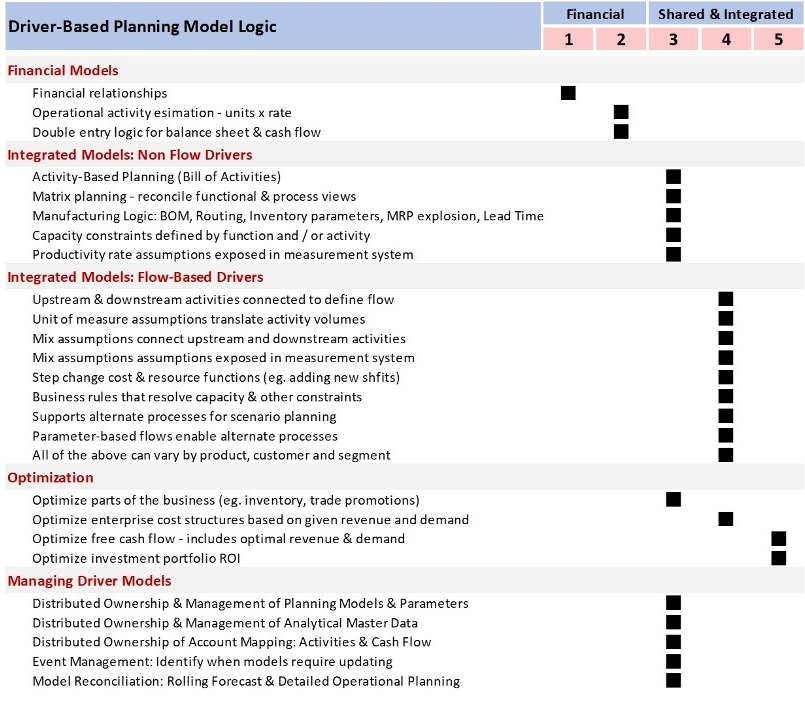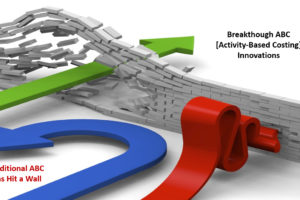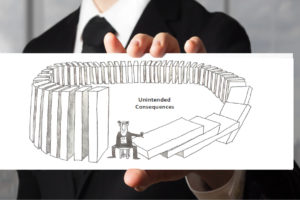Mature driver-based planning models are an essential component of effective rolling forecast processes in complex, global organizations. They provide the foundation for profitable growth by enabling strategy and cost structures to quickly self-adjust to changing business objectives and market conditions.
Introduction
Rolling Forecasts have generated much attention in recent years. Proponents believe the process improves agility by enabling faster and more forward-looking processes. What’s more, they see rolling forecasts as a tool that enables organizations to more effectively respond to change and manage risk.
Skeptics, on the other hand, argue that rolling forecasts waste time and money. They question the value of financially-focused processes that can’t support effective cash flow forecasting, scenario planning and decision support. Moreover, they argue that rolling forecasts do little to resolve functional silos that impede resource allocation. For this reason, they don’t see rolling forecasts and driver-based models as a tool having any strategic significance.
These are two diametrically opposed views. One factor, more than any other, explains the differences in these perspectives. That being immature forms of rolling forecasts and driver-based planning that can’t cope with complexity.
Driver-Based Planning: The Theory
Driver-based planning is an approach for predicting financial results, based on models of underlying operational activity. Drivers refer to the variables – units and rates – that cause resource consumption. In other words, costs! In smaller and simpler organizations, driver-based models are easier to develop and maintain. For example, hotels can derive resources required for room cleaning using the following driver formulas:
-
-
- Rooms to clean = Total number of rooms x occupancy rate
- Hours to clean = Rooms to clean x hours per room
- Cost of cleaning = Hours to clean x rate per hour
-
Operational estimation is a term that describes this form of driver model. It is a financial model that can also be used to forecast personnel requirements and potential capacity constraints. This simple example also illustrates the benefits of integrating financial and operational planning models and processes.
The theory behind driver-based planning is straightforward. Driver models enable better planning processes by making it easier and faster to incorporate changes to plans as conditions change. The idea is that by adjusting a single variable, it can ripple through financial and operational forecasts to show how resource requirements change.
Driver-Based Planning: The Reality
In reality, rolling forecasts and driver-based planning aren’t always so simple. Especially in global organizations having the complexity characteristics shown below in Exhibit 1.

Capturing the complexities of global organizations into a simple “operational estimation” model can be difficult. Maintaining them on an ongoing basis can be even more challenging. This makes it hard to quickly update financial and operational plans and forecasts that:
-
-
-
- Are accurate, at both enterprise segment levels
- Are executable and rooted in operational reality
- Result in optimal revenue, profit and / or cash flow targets
- Are consistent, because key assumptions that connect them are exposed
- Expose financial and operational risks through effective scenario planning
- Establish broad agreement about resources required to achieve objectives
- Achieve the above across multiple functions, business units and legal entities
-
-
What’s more, operational estimation models are often simplified to the point where they don’t support effective scenario planning – one of the primary features of effective rolling forecasts. Good driver models should be able to answer the questions shown in Exhibit 2. Even in wake of key changes, such as the loss of major customer or a key supplier change.

Appreciating how these questions can be answered as part of a rolling forecast process requires a deeper understanding of driver-based planning model maturity.
Maturity Model
Mature driver-based planning is achieved by integrating strategic, financial and operational planning models and processes. What’s common to mature models is that they:
-
-
-
- Are shared by finance and operations, whereas immature ones are maintained and used by Finance only
- Are work / activity-based, in that they quantify operational resources required to deliver specific outcomes
- Distribute ownership of model parameters across organizations, versus maintaining models in finance only
- Expose and manage model parameters and assumptions in integrated measurement systems
- Express financial and operational plans from both functional and business process perspectives, whereas financially-based ones are expressed from functional and chart of accounts perspective only
-
-
The last point refers to a capability called matrix planning. It is important to understand because it provides the foundation for effective productivity management, a capability that can improve profits by up to 5% of sales. I described productivity management in a separate FP&A Trends article that can be accessed here.
With these factors in mind, five types of driver-based models have been defined across two categories; Financial and Integrated. They are summarized in Exhibit 3 and explained in further detail below.

Many organizations use forms of Financial driver models. But few have moved much beyond stage 2, which was illustrated by the hotel example. This fact explains why many global organizations struggle to achieve substantive improvements to cash flow, working capital and foreign currency exposure forecasting. These are classic signs that driver models are not mature / integrated enough to support the business.
Integrated Driver Models
The best way of describing differences between integrated driver models is with an example. Consider the case of a global manufacturer. It loses a major customer that represents one-third of its business. Mature driver models can determine the impact on the business by simply removing customer demand. It would quantify the impact of the change on all activities, from both financial and operational perspectives, from this one simple action. What’s more, multiple scenarios can be evaluated to answer the questions in Exhibit 2.
Driver models that can support such mature planning are referred to as “flow-based” models. This is because they simulate the flow of products, services, orders and other outcomes horizontally across a business and its supply chain. They do this by connecting upstream and downstream activity drivers to quantify resource consumption. For example, customer invoicing can be directly connected to inbound material from suppliers, by way of explicit assumptions that translate orders to shipments to production and then purchasing. What’s more, these connections are maintained by individual flow. Which means these models can result in millions of individual flows.
Driver models that don’t support such detail are referred to as “non-flow” models. These functionally-based models can include embedded operational logic, such as bills of materials, routings, lead times, inventory parameters, and MRP explosion. But this logic is not connected to upstream and downstream activities, requiring that activity volumes be maintained manually. What’s more, they provide limited capabilities for coping with financial and operational constraints.
Optimization is the last type of driver model. These models use mathematics (eg. regression) to find the point at which objective functions are maximized. The most mature form of optimization is when the objective function profit or free cash flow, as illustrated below in stage 5 of Exhibit 4.
Exhibit 4: Driver-Based Planning Model Logic That Supports Maturity Levels

When profit / cash flow is the objective function, optimization models enable organizations to maintain competitive cost structures that enable profitable growth. They do two things to support this. First, they identify revenue and demand (volume and mix) that yields the greatest profit / cash flow. Second, they identify service levels that achieve target customer margins. In so doing, they ensure that targets (that underlie the strategy) are realistic and adequately resourced.
Such models represent the most mature form of optimization. But organizations typically grow into such by models by using optimization in other parts of a business. Inventory, transportation and trade promotion optimization are examples of a model that can be used in parts of a business, as shown in stage 3 above. In stage 4, these models can be consolidated into one that can optimize cost structures.
Managing Driver Models
The key takeaway from the above is that there are distinct differences between driver model maturity levels. As maturity increases, greater insight and value are realized. However, without the right processes, these models can become harder to maintain. Especially in complex organizations. Coping with this complexity requires three things.
First, distributed model ownership. Greater model maturity means that operational models are integrated with financial ones. As a result, finance can work with operational functions to maintain different parts of the model. For example, purchasing can maintain vendor allocations, pricing, discount rates and contracts.
Second, operational model reconciliation. A rolling forecast should represent a strategic view of the business. This typically entails planning at a “family” level. For example, a company may have 100,000 products that comprise operational plans. However, its rolling forecast may be comprised of 500 product family groups. Maintaining effective distributed ownership, therefore, requires the ability to reconcile these high-level planning models with the detailed ones that are used to support operational plans for individual products.
Third, event and master data management. A key enabler of the above is having effective analytical master data management that ensures that people are doing what they are supposed to do. Event management is an important capability in this regard. It ensures that actions are taken as changes are made to master data. For example, as new products are introduced, it ensures that the appropriate attributes and parameters are being maintained.
Armed with these driver management tools, not only can mature driver models create greater value, but they can also make it easier and more cost effective to plan and manage a business.
Conclusion
Many organizations have implemented rolling forecasts, only to find that they don’t deliver expected value and benefits. If your organization is one of them, your driver models probably aren’t mature enough for your business. By understanding the capabilities required to support effective processes, rolling forecasts can be transformed into the value adding tool that many expected. If you’re considering a rolling forecast, you can avoid the missteps of others, by understanding the type of models and processes that you need to achieve your objectives.



